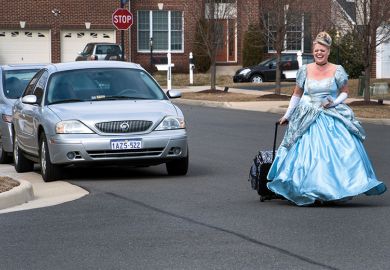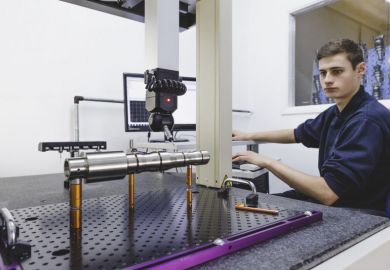When Australians think about tertiary education, their minds typically turn to universities – especially those Australians who have been to university themselves.
Perhaps they think of the dreaming spires of the University of Sydney, the magical campus that is the University of Melbourne, Adelaide University’s beautiful Gothic architecture, the stunning gardens at the University of Western Australia, or the bustling Monash University in Clayton that is so large it has its own postcode. Perhaps they think of their postwar red-bricks, or even the newer shiny downtown towers.
Universities hold special significance in the hearts of many Australians and international students alike, and are a very important part of tertiary education. But when Australians think about tertiary education, they need to think much more broadly.
Vocational education and training (VET) is offered in contexts that are equally impressive in their colour and texture. In the Gothic building of a former primary school within the once-industrial locality of Melbourne’s Cremorne, Bendigo Kangan TAFE students pursue an education in creative and digital skills. Others study at the Volvo company with TAFE NSW, leading the development of zero-emission buses, or develop their screen and media skills at the state-of-the-art, purpose-built Coomera campus of TAFE Queensland, or master automotive trades at the Automotive Centre of Excellence in Docklands, Melbourne. Nestled within the historic West End of Fremantle, others study for employment in the maritime, engineering and marine industries.
When people think about tertiary education, they should not forget the very large number of public and private VET providers across the nation. However, as it stands in the 2020s the university and VET sectors do not come together into a coherent tertiary system – and that needs to change.
For the vast majority of Australians in the 21st century, tertiary education will be critical for success both in the labour market and as citizens. It will not only be important for most young people to take advantage of tertiary education, but also increasingly important for the mature-age workforce to take advantage of it as well. Tertiary education needs to be understood as a core part of the education system, rather than as an add-on.
How can we make a universal tertiary system work coherently for everyone’s benefit? Australia needs an outstanding higher education sector, an outstanding vocational education sector and, between them, an outstanding tertiary system.
There has been growing interest in harmonising vocational and higher education into a more coherent system of tertiary education over the past decade.
There are four main arguments for such harmonisation: first, to enhance the ability of students to navigate the education and training system to obtain the knowledge, skills and capabilities they need to successfully participate in the labour market. Second, to promote equitable access to universal, high-quality tertiary education. Third, to correct for distortions in the incentives for students to participate in one part of the tertiary education and training system rather than another. And, fourth, to encourage vocational education providers, higher education providers and employers to collaborate in the provision of well-designed education and training programs to secure the development of the knowledge, skills and capabilities needed for the Australian economy.
We are in a period of serious skills shortages and low productivity growth, and a period in which government is seeking to decarbonise the economy. These major challenges must be confronted with ambitious and determined reform of the institutions and services that underpin Australia’s economic, social and environmental development. Tertiary education, both vocational and higher, is clearly critical to Australia’s success in meeting these challenges, and it must simultaneously learn to develop itself, in far-reaching ways, to meet the needs and potential of a future Australia.
This system change needs to come from public policy reform, changed funding arrangements, institutional action, innovation, shared investment with industry, and growing alignment among diverse actors operating at different levels across the nation.
The immediate challenge is not merely to identify the necessary policy reforms or changes to funding and regulation that can be implemented in the short term, but to create the relationships, and the common trajectory, that will carry further-reaching change. Individual policy reforms are welcome and necessary but, overall, Australians need all parts of the system to undertake immediate actions that will strengthen the momentum of those changes and create immediate benefit.
A new system is needed because society requires different kinds of skills and different kinds of learners, which the current architecture is unfit to deliver. The ambition is to ramp up Australian learning accessibility and capacity to ensure that every learner has the ability to master what is needed for a particular time and place, at depth; has the skills, attitudes and predispositions to adapt to constant change; embraces new technologies and skills; becomes an enthusiastic lifelong learner; and is able to thrive in a dynamic workforce and contribute to building a responsible and caring community and society.
It’s a big task.
In rethinking tertiary education as not two separate systems but as one system made up of two sectors – vocational education and higher education – we aim to have universally high-quality providers with great diversity. We argue that this diverse system would be bound together by a common architecture and common funding model that ensures high quality and greater connectedness between its parts, and seamlessness in the pathways between its parts and with the school system. It would also have greater connectedness with industry.
The core idea underpinning these arguments is that students should be at the centre. Their needs will be better met by the diversity on offer, stronger pathways and partnerships, and greater transparency, enabling them to navigate the system more easily and to be able to more clearly demonstrate their skills and capabilities to their prospective employers.
This, in turn, will enable the tertiary system to generate the skills that will be required for transforming the Australian economy of the future to achieve strong, inclusive and sustainable growth.
Peter Dawkins is emeritus professor of economics at the Mitchell Institute, Victoria University, where he was previously vice-chancellor. Peter Hurley is director of the Mitchell Institute. Megan Lilly is executive director of the Australian Industry Group’s Centre for Education and Training. Robert Pascoe is dean laureate and professor of history at Victoria. Sarah Pilcher is education policy fellow at the Mitchell Institute. This article is an excerpt from Rethinking tertiary education, published today by Melbourne University Press, which proposes policy reforms based on research and analysis by the late Peter Noonan.
Register to continue
Why register?
- Registration is free and only takes a moment
- Once registered, you can read 3 articles a month
- Sign up for our newsletter
Subscribe
Or subscribe for unlimited access to:
- Unlimited access to news, views, insights & reviews
- Digital editions
- Digital access to THE’s university and college rankings analysis
Already registered or a current subscriber?





